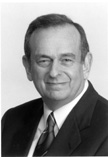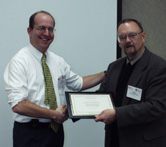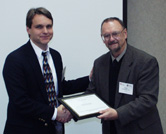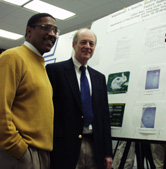UNMC’s Sixth Annual Cardiovascular Research Symposium featured 33 posters and a keynote address by Arthur J. Moss, M.D., who is believed to be the world’s leading authority on the study of patients with Long QT Syndrome — a deadly genetic heart defect found mainly in children.
 Dr. Moss is professor of medicine (cardiology) and director of the Heart Research Follow-up Program at the University of Rochester School of Medicine and Dentistry in Rochester, N.Y. He also is editor of the Annals of Noninvasive Electrocardiology, serves on the editorial board of several cardiology journals, and serves on the study section and special emphasis panels of the National Institutes of Health. His Feb. 15 keynote lecture titled, “Lessons Learned from the Long QT Syndrome: Genes, Drugs and Devices,” was simultaneously broadcast to symposium attendees in the Storz Pavilion and University Hospital.
Dr. Moss is professor of medicine (cardiology) and director of the Heart Research Follow-up Program at the University of Rochester School of Medicine and Dentistry in Rochester, N.Y. He also is editor of the Annals of Noninvasive Electrocardiology, serves on the editorial board of several cardiology journals, and serves on the study section and special emphasis panels of the National Institutes of Health. His Feb. 15 keynote lecture titled, “Lessons Learned from the Long QT Syndrome: Genes, Drugs and Devices,” was simultaneously broadcast to symposium attendees in the Storz Pavilion and University Hospital.
“The thing that separates Dr. Moss as a world-leading researcher is that any cardiologist can call him with an EKG question and he will take your call,” said John R. Windle, M.D., professor in internal medicine cardiology.
Dr. Moss commented on a large clinical concern about acquired or drug induced QT prolongation. As the world leader in understanding the long QT syndrome, he has supported many investigators in studying the heart defect.
 Long QT syndrome is particularly tragic because it is a genetic defect that can show up as early as infancy and is very difficult to identify postmortem. It can be particularly devastating because it often will run in a family, striking the youngest members, rather than the other end of the age spectrum.
Long QT syndrome is particularly tragic because it is a genetic defect that can show up as early as infancy and is very difficult to identify postmortem. It can be particularly devastating because it often will run in a family, striking the youngest members, rather than the other end of the age spectrum.
Dr. Moss has expertise in the genetics of the long QT channels that indicate where the defect may show up. Clinicians are now able to acquire gene specific treatments for some of these patients — a major advancement due to Dr. Moss’s pioneering work.
“Dr. Moss wants everyone to succeed,” Dr. Windle said. “He will support everyone and try to help you get your work done. He is incredibly accessible.”
A similar spirit of collaboration exists with researchers across the UNMC campus.
“This annual symposium is where our investigators compare notes and invariably new collaborations arise to pursue new grants as a consequence,” said UNMC’s Vice Chancellor for Research Thomas Rosenquist, Ph.D.
“We measure the maturity of UNMC’s research program by the increase in NIH training grants and large program-type grants. We currently have three training grants and one is a cardiovascular training grant. We have four large program-type grants and two of those are cardiovascular. Cardiovascular research has grown substantially on this campus.”
According to Dr. Rosenquist, the symposium is an efficient way for researchers to get together and exchange information. The 33 research posters were placed tightly together in three rows. As researchers walked up and down each aisle, they often met like-minded colleagues for the first time.
In addition, the annual symposium honors one poster from the clinical category and one from basic research with a certificate of merit and $250. David A. Danford, M.D., professor in the department of pediatrics cardiology, and George Rozanski, M.D., professor, and Zhi Xu, research associate, in the department of physiology/biophysics, received the basic science award.
 Four other oral presentations followed Dr. Moss’s luncheon lecture. The speakers included John D. Kugler, M.D., professor in pediatrics cardiology; Dr. Rozanski; Dr. Windle; Christopher Erickson, M.D., associate professor of pediatrics and director of electrophysiology for pediatric cardiology; and Lorraine G. Olson, Ph.D., professor and chair of mechanical engineering at the University of Nebraska-Lincoln.
Four other oral presentations followed Dr. Moss’s luncheon lecture. The speakers included John D. Kugler, M.D., professor in pediatrics cardiology; Dr. Rozanski; Dr. Windle; Christopher Erickson, M.D., associate professor of pediatrics and director of electrophysiology for pediatric cardiology; and Lorraine G. Olson, Ph.D., professor and chair of mechanical engineering at the University of Nebraska-Lincoln.
Photos (in descending order): 1) Arthur Moss, M.D.; 2) Scott Fletcher, M.D., pediatric cardiology, and co-author, accepts the award for top Clinical Poster from Thomas Rosenquist, Ph.D. David Danford, M.D., professor in pediatrics cardiology, is investigator; 3) George Rozanski, M.D., investigator, accepts the award for top Basic Sciences poster from Dr. Rosenquist. Zhi Xu Ph.D., research associate in the department of physiology/biophysics, is co-author; 4) LeDon Bean, left, graduate student in the BSTP training program, at his poster with co-author Charles Murrin, Ph.D., professor and vice chairman of the department of pharmacology.